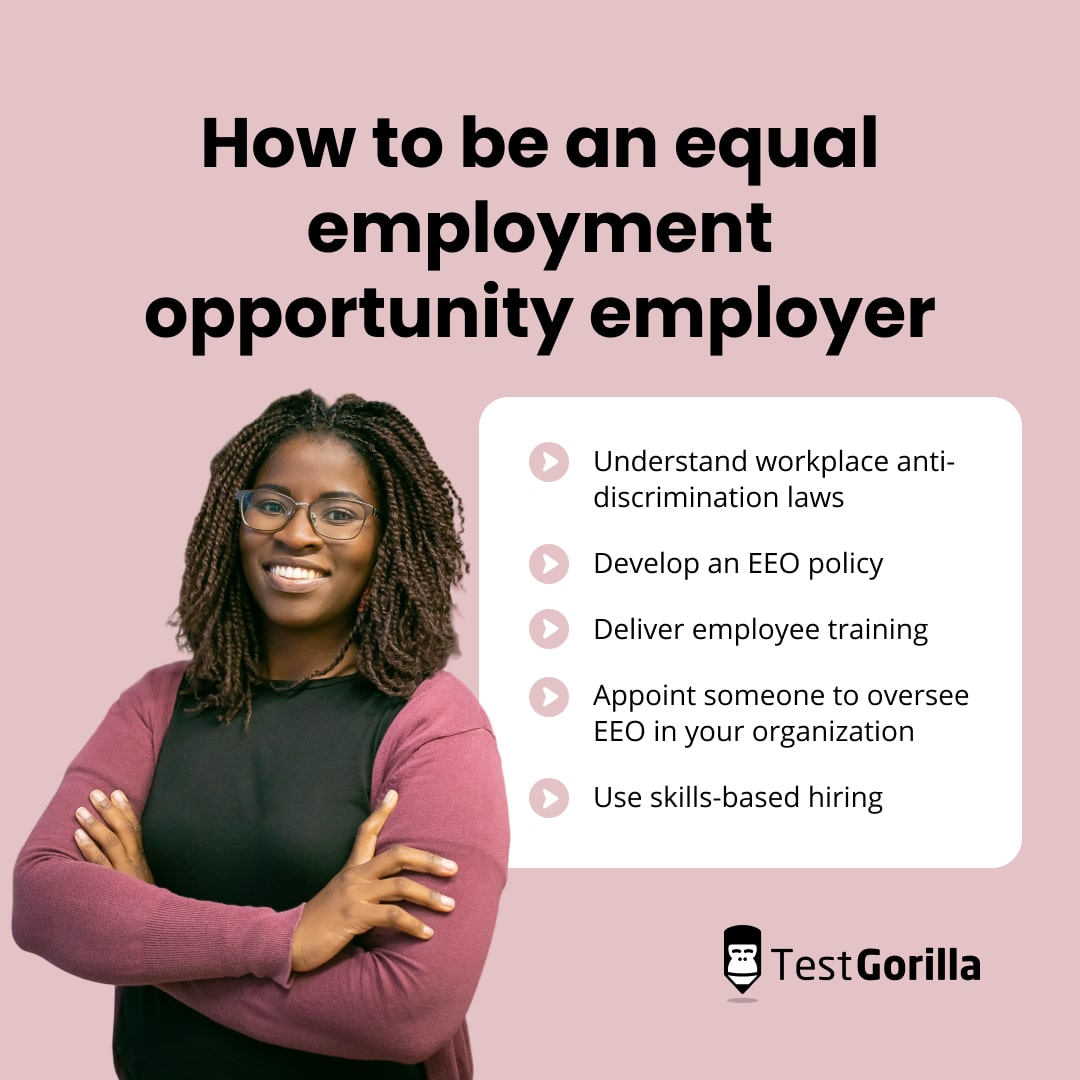Equal employment opportunity (EEO) is a principle that promotes diversity, equity, and inclusion (DEI) in the workplace. It guarantees fair treatment in employment decisions, such as hiring, compensation, and termination.
In the US, various anti-discrimination laws protect EEO. Understanding these laws and your EEO responsibilities as an employer is crucial to avoiding potential fines and lawsuits.
This article explains how EEO benefits employees and employers and how you can comply with your obligations, including steps to support EEO in your workplace.
Table of contents
What is equal employment opportunity (EEO)?
EEO is a principle that emphasizes fair treatment in all employment decisions. A key tenet of EEO is that employers cannot discriminate against individuals or deny them employment opportunities based on personal characteristics like race, age, or disability.
EEO applies to all employment decisions, including job advertisements, hiring, promotion, training, wages, benefits, conditions of employment, discipline, and termination.
For hiring, EEO requires merit-based decision-making. Employers must assess candidates based on objective, job-related criteria such as qualifications, references, interviews, and pre-employment testing. For example, you can’t reject a candidate because they’re pregnant or practice a different religion than you.
There’s no overarching EEO law in the US. Instead, various federal and state anti-discrimination laws make anti-EEO practices unlawful. Title VII of the Civil Rights Act prohibits employers with 15 or more employees from discriminating against someone based on protected characteristics.
These characteristics are race, color, national origin, religion, sex, age (40+), disability, and genetic information. Protected characteristics have typically been determined based on historical experiences of systemic discrimination, prejudice, and underrepresentation faced by certain groups.
Equal employment opportunity is important because it ensures a fairer workplace and promotes DEI. Diverse workplaces offer many benefits, including increased employee engagement and productivity, reduced turnover, and greater innovation.
Key EEO terms explained
Here are some EEO terms you should be aware of:
Equal Employment Opportunity Commission (EEOC)
The EEOC is a federal body that oversees national anti-discrimination and anti-harassment laws, including Title VII of the Civil Rights Act, the Age Discrimination Act, the Pregnancy Discrimination Act, the Equal Pay Act, and the Americans with Disabilities Act.
EEO-1 reports
US organizations with over 100 employees or those with government contracts worth more than $50,000 and more than 50 workers must file annual EEO-1 reports with the EEOC. These reports detail workforce information on ethnicity, race, and gender for data collection purposes.
While you’ll face no financial penalties for not filing an EEO-1 report, the EEOC can ask a court to compel you to file one – for example, during an investigation of alleged discrimination. Federal contractors that fail to file reports could have their contracts terminated. Plus, if you intentionally make a false statement in an EEO-1, you can face fines and imprisonment.
Bona fide occupational qualification (BFOQ)
This provides limited exceptions to workplace anti-discrimination laws. When making employment decisions for a specific role, you can consider protected characteristics if they’re directly tied to the job’s tasks.
Examples of possible BFOQs include:
An airline including an age cut-off of 65 in its job advertisements in line with the mandatory pilot retirement age
A casting agency hiring actors of certain genders, races, and ages to portray characters with those characteristics
A religious institution promoting only employees of faith to certain leadership roles
Affirmative action
Affirmative action refers to policies and practices that promote workplace diversity by supporting protected groups. For example, a law firm that wants to address the underrepresentation of women lawyers could partner with a law school with high female enrollment to involve more women in the recruitment process. Another affirmative action strategy is hiring quotas, which some companies use to ensure racial diversity, especially in leadership positions.
While you can’t hire someone based solely on a protected characteristic, affirmative action helps attract diverse candidates. It’s worth noting that some states – including Florida, Washington, and California – ban affirmative action in certain situations.
Reasonable accommodations
Employers must give candidates and employees with disabilities reasonable accommodations to access EEO unless doing so would cause the employer “undue hardship.” This may include workspace modifications or flexible hours. For example, employees who use wheelchairs may request larger work cubicles and desk height adjustments.
Equal pay for equal work
This principle prohibits wage discrimination. Employees doing the same job with the same experience level and qualifications must receive equal pay.
The best insights on HR and recruitment, delivered to your inbox.
Biweekly updates. No spam. Unsubscribe any time.
What are the advantages of equal employment opportunity?
Equal employment opportunity has the following advantages:
Encourages diverse hires
As an EEO employer, you can ensure your workforce mirrors society with a range of employees from various backgrounds. Workplace diversity helps employees feel more comfortable, leading to higher job satisfaction.
According to the International Labor Organization, workforce diversity improves employee productivity and engagement, resulting in stronger financial performance and innovation.
Expands your talent pool
EEO-compliant hiring practices widen your candidate pool to make way for top talent. By ensuring your hiring practices are fair, you’ll give each candidate with merit an equal chance at employment.
Promotes transparency and openness
A commitment to EEO fosters a culture of transparency within your organization. You must prioritize openness, accountability, and fairness to implement EEO strategies and practices like pay equity and anti-discrimination policies. This transparency improves employee engagement and retention and enhances your organization’s reputation.
Builds a positive organizational reputation
Organizations that don’t support EEO face public scrutiny. Prioritizing EEO shows that you value your employees and prioritize their well-being. This makes your organization more attractive to potential hires and builds trust with clients and customers.
What are the disadvantages of equal employment opportunity?
Equal employment opportunity has the following downsides:
Surface-level solution
Some view current EEO practices as a superficial solution to a lack of diversity because they primarily address the symptoms of inequality rather than its root causes. An example that highlights this is an EEO employer requiring college degrees for certain roles.
Although this requirement seems neutral and non-discriminatory, it automatically disqualifies individuals who face educational barriers due to economic, gender-related, or other reasons. That’s why using various strategies to prevent discrimination and support inclusion in your organization is essential.
Cost of implementation
Like any workplace improvement, becoming an EEO employer demands time and effort. The results of EEO initiatives are not immediate since your organization often requires time and money to review existing practices and implement necessary changes. However, considering the benefits to candidates, employees, and employers, these investments are worth it.
How to be an equal employment opportunity employer
Understand workplace anti-discrimination laws
Regularly monitor the federal and state EEO laws that apply to your business because they frequently change. Staying up to date is crucial to ensuring your policies and practices comply and avoiding fines or lawsuits.
Develop an EEO policy
Create a clear EEO policy stating your commitment to EEO and your organization’s EEO practices. Your EEO policy should, at a minimum, comply with the relevant laws and regulations that apply to your business.
However, many employers take a more proactive approach and identify other ways to promote EEO in their workplace – for example, with training or affirmative action plans.
Writing your policy down ensures employees can easily access it and implement it consistently across your organization.
Deliver employee training
Training your employees – including your hiring managers – helps them understand their obligations around EEO and DEI. It equips them with the knowledge and skills to prevent discrimination and support workplace EEO.
Appoint someone to oversee EEO in your organization
You can appoint someone in your organization to oversee EEO and ensure your workforce consistently implements your strategies. This person must have a good understanding of employment law, especially anti-discrimination law.
Use skills-based hiring
Pre-employment assessments are a great way to ensure your hiring process is fair. An objective assessment of candidates’ job-related skills, cognitive abilities, and personality traits supports merit-based hiring.
Keep EEO and accessibility in mind when choosing a pre-employment testing platform. For example, TestGorilla lets candidates request any accommodations they need to complete testing.
How TestGorilla supports equal employment opportunity
Ensuring fair employment practices in your organization supports the well-being of your employees, making them more productive and engaged and resulting in better business outcomes. Failing to comply with EEO laws can result in fines or lawsuits.
Using pre-employment testing for unbiased insights into candidates is a great way to support EEO in hiring practices. TestGorilla offers personality, cognitive ability, and job-related skills testing to help you find the best person for the job based on merit.
Explore TestGorilla’s free plan to see how it can enhance EEO hiring in your organization.
Disclaimer
The information in this article is a general summary for informational purposes and is not intended to be legal advice. Laws are subject to constant change, and their applications vary based on your individual circumstances. You should always seek legal advice from a qualified attorney about your legal obligations as an employer. While this summary is intended to be informative, we cannot guarantee its accuracy or applicability to your situation.
You've scrolled this far
Why not try TestGorilla for free, and see what happens when you put skills first.



















